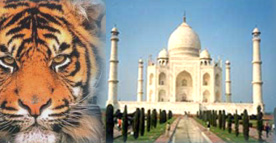|
Among the famous monuments of India, none is more fascinating than the Taj Mahal. The pinnacle of medieval architecture was achieved in this mausoleum built by the Mughul Emperor Shahjahan in the 17th century AD. The immense size and grandeur along with its sublime spiritual appeal makes the Taj Mahal one of the most popular tourist attractions in India. Located in the city of Agra in Uttar Pradesh, the Taj Mahal stands out among the highlights of tourism in India.
The magnificent Taj mahal was built by the 5th Mughul emperor Shahjahan in memory of his beloved wife, Mumtaz Mahal, also known as Arjumand Bano Begum. She was his favorite wife and she bore him 14 children. She died at childbirth in 1631, and thus attained martyrdom. This is why the tomb of Mumtaz mahal was designed to be a mausoleum, as well as place of pilgrimage where religious festivals would be held.
The design of the Taj mahal has been inspired by the description of the garden of paradise in the Holy Quran. The best architects, craftsmen and masons were summoned from all over the world for this project of mammoth proportions. In those days, it cost nearly 41 million rupees, and involved the use of over 500 kilos of gold. The immense structure was completed in 1643, after 12 years of work by about 20,000 workers.
The Taj Mahal features the Charbagh garden style brought to India by the Mughuls, who originated from arid lands of central Asia, and liked their palaces and other structures to be opulent in greenery and water. The charbagh of the Taj is perfect in symmetry. The lotus pool in the middle of the garden reflects the monument in all its glory and is a popular spot among tourists for photographing themselves.
The main structure is made up of white marble, procured from Makrana in Rajasthan. The dome is the most prominent part of the main structure. It rises to 44 meters (144 feet) and is topped by a finial. Four minarets, each 40 meters (131 feet) tall, surround the main building on four sides. These are topped by open octagonal pavilions, known as chatris. The minarets have been deliberately made shorter than the main building to highlight the supremacy of the central structure.
The actual tombs of Mumtaz Mahal and Shahjahan, who was also buried here, lie in a crypt below the cenotaphs. They are now closed for public viewing. The cenotaphs are richly decorated with magnificent calligraphy. They are surrounded by a beautiful screen carved out of a single block of marble. It is an example of the amazingly intricate artistry of the artisans working on the Taj.
The decorative elements of the Taj are as interesting and attractive as its architecture. Pietra Dura inlay work, using precious stones in marble, has been used extensively in the Taj. Simple flower designs have been executed with remarkable artistry, making the whole monument exude an earthly beauty. Similarly, the best calligraphers of the time were assigned the task of decorating the Taj with verses from the Quran. The calligraphy has been executed with black marble which stands out on the white surface.
The main building is flanked by two red sandstone buildings on the western and eastern sides. The western building is the mosque, while the eastern building was known as the mahman khana, or guest house.
The Taj signifies the ultimate amalgamation of Persian, Turkish, Indian and Islamic architectural styles. It represents the best that the 17th century had to offer in architecture. Declared a world heritage site by the UNESCO in 1983, the Taj Mahal remains one of the most visited and loved historic monuments of the world.
Learn more about the Taj Mahal and tourism in Agra in touristplacesinindia.com.
Back to Seven Wonders of India
 |
|

